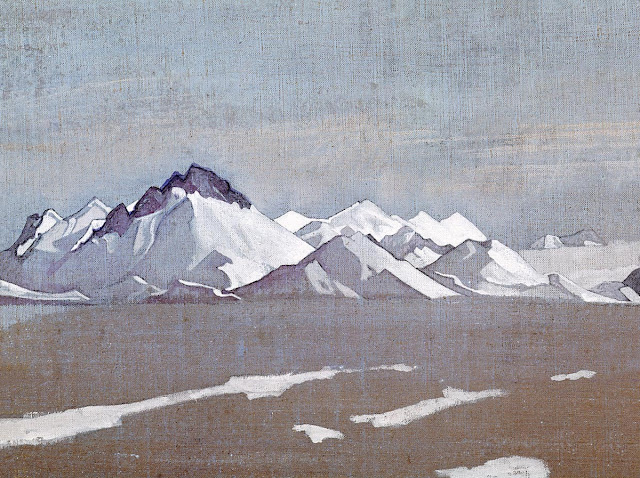VASILY DMITRIYEVITCH POLENOV (1844-1927)
Mount Hermon / Jabal Haramun / Har Hermon (2,814m- 9,232 ft)
Lebanon - Syria -Israel
In At the foot of Mount Hermon, 1882, oil on canvas, Tretiakov State Gallery, Moscow
The mountain
Mount Hermon or Jabal Haramun or Har Hermon (2,814m- 9,232 ft), in arabic جبل الشيخ or جبل حرمون, in hebrew הר חרמון, is a mountain cluster constituting the southern end of the Anti-Lebanon mountain range. Its summit straddles the border between Syria and Lebanon and,is the highest point in Syria. On the top, in the United Nations buffer zone between Syrian and Israeli-occupied territories, is the highest permanently manned UN position in the world, known as "Hermon Hotel".The southern slopes of Mount Hermon extend to the Israeli-occupied portion of the Golan Heights, where the Mount Hermon ski resort is located. A peak in this area rising to 2,236 m (7,336 ft) is the highest elevation in Israeli-controlled territory.
Mount Hermon is a sacred moutnain mentionned in many sacred texts and epic tails.
The Epic of Gilgamesh mentions that Mount Hermon split after Gilgamesh kills Humbaba, the Guardian of the Cedar Forest. One translation of Tablet V states, "The ground split open with the heels of their feet, as they whirled around in circles Mt. Hermon and Lebanon split."
In the Book of Enoch, Mount Hermon is the place where the Watcher class of fallen angels descended to Earth. They swear upon the mountain that they would take wives among the daughters of men and take mutual imprecation for their sin (Enoch 6).
The mountain or summit is referred to as Saphon in Ugaritic texts where the palace of Ba'al is located in a myth about Attar.
The Book of Chronicles also mentions Mount Hermon as a place where Epher, Ishi, Eliel, Azriel, Jeremiah, Hodaviah, and Jahdiel were the heads of their families.
R.T. France, in his book on the Gospel of Matthew, noted that Mount Hermon was a possible location of the Transfiguration of Jesus.
Various Temples of Mount Hermon can be found in villages on the slopes. There is a sacred building made of hewn blocks of stone on the summit of Mount Hermon. Known as Qasr Antar, it is the highest temple of the ancient world and was documented by Sir Charles Warren in 1869. An inscription on a limestone stele recovered by Warren from Qasr Antar was translated by George Nickelsburg to read "According to the command of the greatest a (nd) Holy God, those who take an oath (proceed) from here."
Eusebius recognized the religious importance of Hermon in his work Onomasticon, saying "Until today, the mount in front of Panias and Lebanon is known as Hermon and it is respected by nations as a sanctuary". It has been related to the Arabic term al-haram, which means "sacred enclosure". Another Greek inscription found in a large temple at Deir El Aachayer on the northern slopes notes the year that a bench was installed "in the year 242, under Beeliabos, also called Diototos, son of Abedanos, high priest of the gods of Kiboreia".
In Psalm 42, which leads the Psalms of the northern kingdom, the Psalmist remembers God from the land of Jordan and the Hermonites. In Song of Songs 4:8, Hermon is an instance of an exotic locale, and the Song of Ascents as well as Psalm 133:3 make specific reference to the abundant dew formation upon Mount Hermon.
According to the controversial research by Professor Israel Knohl of the Hebrew University, in his book "Hashem", Mount Hermon could be actually the Mount Sinai mentioned in the bible, with the biblical story reminiscent of an ancient battle of the northern tribes with the Egyptians somewhere in the Jordan valley or Golan heights.
The painter
Vasily Dmitrievich Polenov (Васи́лий Дми́триевич Поле́нов) was a Russian landscape painter associated with the Peredvizhniki movement of realist artists. A native of St. Petersburg, Polenov studied under Pavel Chistyakov and at the Imperial Academy of Arts from 1863 to 1871. He was a classmate and close friend of Rafail Levitsky, a fellow Peredvizhniki artist and famous photographer.
Polenov was a pensioner of the academies of arts in Italy and France, where he painted a number of pictures in the spirit of Academism on subjects taken from European history, such as "Droit du Seigneur" (1874) Tretyakov gallery; at the same time he worked a lot in the open air.
Polenov took part in the Russo-Turkish War (1877-1878) as a war artist. Returning from the war, he joined the Peredvizhniki, taking part in their mobile exhibitions. His works won the admiration of Pavel Mikhailovich Tretyakov, who acquired many of them for his gallery.
In the late 1870s, Polenov concentrated on painting landscapes in the realist tradition of Aleksey Savrasov and Fyodor Vasilyev. He attempted to impart the silent poetry of Russian nature, related to daily human life. He was one of the first Russian artists who achieved a plein air freshness of color combined with artistic finish of composition (The Moscow courtyard, 1878; The Grandmother's garden, 1878; Overgrown pond, 1879). The principles developed by Polenov had a great impact on the further development of Russian (and especially Soviet) landscape painting.
Polenov's sketches of the Middle East and Greece (1881–1882) paved the way for his masterpiece, "Christ and the Sinner" (1886–87), an interesting attempt to update the academic style of painting. In his works of the 1880s, Polenov tended to combine New Testament subjects with his penchant for landscape.
Polenov was elected a member of the St.Petersburg Academy of arts in 1893, and named as a People's Artist of the USSR in 1926. For many years, he coached young painters in the Moscow School of Painting, Sculpture and Architecture. His pupils included Abram Arkhipov, Isaac Levitan, Konstantin Korovin, Emily Shanks and Alexandre Golovine.

























